Misc
HORROR 101: The J-Splatter Craze of the 2000’s (And Why It Still Rules)

Welcome back to Horror 101, a series of articles where we explain horror movie legends and their lore. For beginners, the confused, or just those who need a refresher, these articles are for you. You know, for someone who is constantly calling horror movies camp, I really didn’t realize how important campiness was to the horror movies I watched growing up. I gravitate towards the silly, and the J-horror subgenre of J-splatter is where some of the silliest and bloodiest visuals in all of horror are. For me, this article is a walk down memory lane alongside Horror Press readers, returning to the first J-horror I was ever introduced to and learning more about its creation and history from the late 90’s into the 2010’s.
And hopefully for those of you who are uninitiated in the madness that Japanese splatter films have to offer you, this is a crash course on an untapped wellspring of horror entertainment. So, sharpen your swords and make sure your heart rate is bumping, as we dive into the first question…

WHAT ARE J-SPLATTER FILMS?
Like all genres, setting hard boundaries for what J-Splatter is might be a futile task. But I will try to define its most important aspects. J-Splatter is a subgenre of J-horror defined by its special effects-driven spectacles, with an emphasis on blood, guts, body horror, and incredibly stylized violence, released between the late 90s and the present day. The spectacle of it all is vital, as tonally J-Splatter is very rarely about being emotionally heavy or horribly disturbing. J-Splatter films are a fun grindhouse affair, more often than not veering into horror comedy with splashes of melodrama in between.
WHAT ARE THE GENRE TROPES OF J-SPLATTER FILMS?
The protagonists are rarely everyday people, ranging from rock stars to hotshot cops to cybernetically enhanced yakuza and schoolgirls. The leads are typically superhuman and face mutants, zombies, and robots as their main opposition; when the muscle meets the monsters, machine gun arms rev up, and heads roll. And we win because we get to see it all!
Despite how many people might count the Guinea Pig films or some of the more violent 1970s J-horror films as splatter horror, they just don’t fit into the subgenre tonally and miss the rough window of time in which these films got popular. They’re too cruel and offer little levity compared to films like Wild Zero, and even more story-heavy affairs like Tokyo Gore Police, which are first and foremost fun.
In short, if the execution and kills are more Fede Alvarez’s Evil Dead, but the sensibility and tone are more like dark comedy Looney Tunes, you’ve got yourself a Japanese splatter film.

HOW DID THESE FILMS BEGIN?
Before we get into what splatter films are, we should probably explain how and when they emerged. With the cultural exchange of American exploitation films influencing Japanese filmmakers from the mid-60s into the 70s, Japanese cinema became more daring as it left its hushed post-war period: between more violent action and crime films, and the erotic thriller “Pink Film” boom leading to a financial arms race between studios, pushing the envelope of visual scintillation became the name of the game in Japan as much as it was abroad.
And by the 80s, all of the filmmakers who had grown up on these boundary-pushing films ended up being cut loose into the independent film market. Dubbed “The V-Cinema era,” the 80s and 90s Japan saw the growth of a healthy ecosystem of direct-to-video films that resulted from the proliferation of VHS distribution; a lack of regulation for these films allowed them to be as weird and wild as their creators would let them. Many early J-Horror films emerged, starting a craze of supernatural and tokusatsu horror movies.
While it wasn’t proper J-Splatter due to its experimental nature and oppressive tone, Shinya Tsukamoto’s Tetsuo: The Iron Man (1989) and its follow-up Tetsuo: The Body Hammer (1992) codified a lot of the splatter film visuals in terms of body horror and weird cybernetics. The idea of body parts being transfigured into machines in a really nasty manner was popularized by Tetsuo and became a mainstay of the subgenre.
Along with increasingly popular original video animations like Wicked City and Lily C.A.T., gruesome cinema began to shine and push itself into the Internet age. And so, the escalation of making films even weirder and wilder birthed a new subgenre of film: J-Splatter.
WHAT WERE THE FIRST J-SPLATTER FILMS?
Because J-Splatter popped off during the V-Cinema era (where there are just too many effects-driven action and horror movies to count), it’s really hard to pin down one film as the first. However, the most notable of J-Splatter’s early entries is legendary Japanese director Takashi Miike’s Full Metal Yakuza (1997). This is Japan’s real steel answer to Robocop, which summons the tropes of Yakuza mobster movies; it features a cybernetically enhanced Yakuza member who is brought back from the dead by fusing machine parts and the pieces of his dead friend into his body.
He then of course goes to literally punch off his enemy’s heads. I highly recommend it.
The first J-Splatter to adopt its iconic horror comedy overtones might be Wild Zero (1999). Starring real-life Japanese rock band Guitar Wolf, it follows punk fan Ace, who accidentally becomes bonded to Guitar Wolf just before aliens incur a zombie apocalypse. He ends up fighting alongside them, learning about love and honor along the way. This one is very over the top and was an instant success because of its lighthearted, pulpy take on zombie horror. It’s still a well-loved film, and it even has a sequel in the works 25 years later.
Versus and Junk Zombie Hunter doubled down on the increasing popularity of zombies at the turn of the millennium. They were both popular for their high-impact and high-intensity action sequences. Between their cost effectiveness, and the fact you could squeeze out a comedically high and aesthetically messy body count, zombies were a ceaselessly popular choice for J-Splatter cannon fodder.

WHO ARE THE MOST IMPORTANT DIRECTORS FOR THIS GENRE?
The 2000s saw another J-splatter hit from Takashi Miike with the very controversial and nauseatingly violent Ichi the Killer (2001), about a man being brainwashed into serving as a hitman for the Yakuza at the behest of a super-sadist. The same year brought the puzzling thriller Suicide Club, and the international hit Battle Royale, which while not J-splatter, still showed a demand for ultraviolent fiction by Japanese audiences in the early aughts.
Around this time, the screenwriter of Versus, Yudai Yamaguchi, began to work on more and more films focused on crazy effects. Battlefield Baseball (2003) became the appetizer for his much more popular work Meatball Machine (2005). Whereas Baseball is a cartoonish venture that turns a baseball diamond into a warzone against undead punks, Meatball Machine was a streamlined homage to the Tetsuo films, this time embracing full-color splatter and intense body horror. It follows an epidemic involving mysterious giant bugs that latch onto humans, subsequently turning them into cannibalistic cyborgs, called Necroborgs.
It is a pretty dark film outside of its insane visuals and campy directing, with a very low-budget veneer. It’s a lot like The Evil Dead, and the film feels aware of it, given it makes some obvious references to the Raimi classic. What makes Meatball Machine important is that its production brought a key figure of the movement onto the scene: director Yudai Yamaguchi brought on Yoshihiro Nishimura, a special effects wizard and veteran of the industry whose makeup here would define the genre.
Meatball Machine allowed Nishimura a chance to make some very chunky designs for the film’s villains. Part television tokusatsu and part endgame Resident Evil monstrosity, Nishimura cut his teeth on the Necroborgs, making bizarre man and machine fusions that would become a signature of his many future films.

HOW DID YOSHIHIRO NISHIMURA BECOME THE MASTER OF J-SPLATTER?
Truly, if anyone was the icon of the J-Splatter craze, it was Nishimura. And when I say craze, what I’m actually referring to is his crazy work ethic. He went on to direct a sequel to his film with Yamaguchi, the more polished Meatball Machine: Reject of Death (2007). This set off a hot streak for the SFX maven, where he began working on more and more J-Splatter films throughout the following decade.
As a matter of fact, it’s nearly impossible to find films in the subgenre that he wasn’t involved in. Even the movies he didn’t direct firsthand he had a part in, often as a makeup designer or an overall special effects supervisor. Working with a team of talented makeup artists, he was the driving spirit of the film’s creature designs and most insane set pieces; and by extension, he became the driving spirit of J-Splatter at large.

WHEN DID J-SPLATTER BECOME POPULAR IN AMERICA?
2008 was Nishimura’s year as it saw the release of three more iconic J-Splatter: The Machine Girl, Yoroi Samurai Zombie, and the instant cult classic Tokyo Gore Police. Tokyo Gore Police follows the war between biopunk monstrosities called Engineers and the human monsters of the brutal Tokyo Police Force. Caught in the middle of it all is the skilled T.P.F. officer Ruka, who hunts for the man who killed her father. When she crosses paths with the Engineers maker, Key Man, she ends up learning the truth behind his death is stranger than any mutant she could have run into.
Tokyo Gore Police was undoubtedly the feature that had the most crossover with American audiences, primarily due to its run in North American film festivals like Fantasia Fest where it wowed audiences with its off-the-wall visuals like people jettisoning around on blood jets, and women’s lower halves turning into alligators.
It managed to secure a pretty significant home release in the U.S. the following year due to its festival victory lap, and I very vividly remember seeing a review of the DVD on G4TV as a kid and being enchanted by the hype of it all. I immediately struggled to look through F.Y.E. and my local dying Blockbuster to find a copy the following week. It’s a really great movie and quintessential viewing for fans of the genre, so definitely check this one out.

WHY ARE THESE FILMS LESS POPULAR TODAY?
Moving into the 2010s, Nishimura went on to direct Mutant Girl Squad and the highly underrated Helldriver (2010), which follows a woman using a chainsword powered by her own artificial heart to fight against demonic zombies taking over Japan. If you weren’t hooked by chainsword powered by her own artificial heart, this might not be the subgenre for you. Even when he wasn’t directing, his special effects mastery was used on a dozen other films in the 2010s with evocative titles like Gothic Lolita (2010), Psycho (2010), and Dead Sushi (2012); he even reunited with Yudai Yamaguchi for the film Yakuza Weapon (2011).
However, as the decade went on, the trend of J-Splatter became less popular with critics and audiences, and other horror subgenres in Japan (like the resurgence of films about ghosts and hauntings) rose in popularity. Of course, there were other factors; studio horror movies were becoming less common, and what horror was coming out was usually not being exported with the frequency it was years prior. And so, the steady stream of protagonists whose bodies had been turned into living weapons began to decline, as remakes and adaptations hit their stride in Japan, as is the eternal ebb and flow of popular cinema.
As of the late 2010s and into the 2020s, the head of the subgenre has taken a big step back; Yoshihiro Nishimura has worked on mostly non-splatter films, lending his makeup talents to dramas and more strait-laced action and sci-fi. From what I can tell, his last venture into J-splatter was another sequel in 2017, the follow-up to where it all started with Meatball Machine: Kodoku. I would usually be worried, but, I have faith that one day the master of blood geysers will return, and a whole bunch of other inspired filmmakers who grew up on his work with him.

WHAT J-SPLATTER FILMS SHOULD I WATCH?
So, now that you’ve learned a little about the history of J-Splatter, you’re undoubtedly going to want to watch some. But where to start? You might also be wondering why some movie titles throughout this article are bold while others aren’t. The bolded titles in this article are all personal favorites of mine, and ones I think most people just jumping into the subgenre will really enjoy. The recommendation was there the whole time, what a twist!
Full Metal Yakuza, Wild Zero, Battlefield Baseball, Meatball Machine, Tokyo Gore Police, and Helldriver are my selections not just for their individual quality, but because they are what I would consider a perfect assortment of J-Splatter for a marathon. I didn’t expect most of these to hold up as well as they did on rewatch, thinking my nostalgia goggles had blinded me. But Tokyo Gore Police is just that good, and Battlefield Baseball is just that incredibly funny. (I do have to say, maybe skip Ichi the Killer for a marathon and watch it on its own. I highly recommend it, but it’s heavy despite the absurdity of some of its deaths.)
One that I didn’t get to touch on above is Red Tears, which is a J-Splatter take on a vampire film; it buries the lead by presenting itself as a slasher with a police procedural slant at first, but as with all of these films, goes absolutely insane. Sion Sono’s Tag is also another that feels more splatter adjacent with some very dark humor and a surreal plot, but it is well worth watching for how strange it gets. And Yudai Yamaguchi’s Deadball is effectively a spiritual successor to Battlefield Baseball, with a modern film’s visual clarity and some newer effects.
And really, you can’t go wrong with most Nishimura selections. And I think it’s because of his philosophy approaching these films. In an interview with Asian Movie Pulse, he gives a great insight into the spirit of his filmmaking: “I want to create a ‘wave’ to the audience. I want to show something gross but at the same time, I want to make them chuckle. I would like to show something nobody has ever seen before. What I create is entertainment.”
And entertaining they are. You can’t really go wrong with any of his films, so your homework for today’s lecture? Go forth and find the one that speaks most to you. For its blood, for its metal, and for its love. Happy watching horror fans!
***
And that will be it for today’s Horror 101 lesson. See you in the next class, and stay tuned to Horror Press’s social media feeds (@HorrorPressLLC on Twitter and Instagram) for more content on horror movies, television, and everything in between!
Misc
Our Halloween Giveaway Is Here!
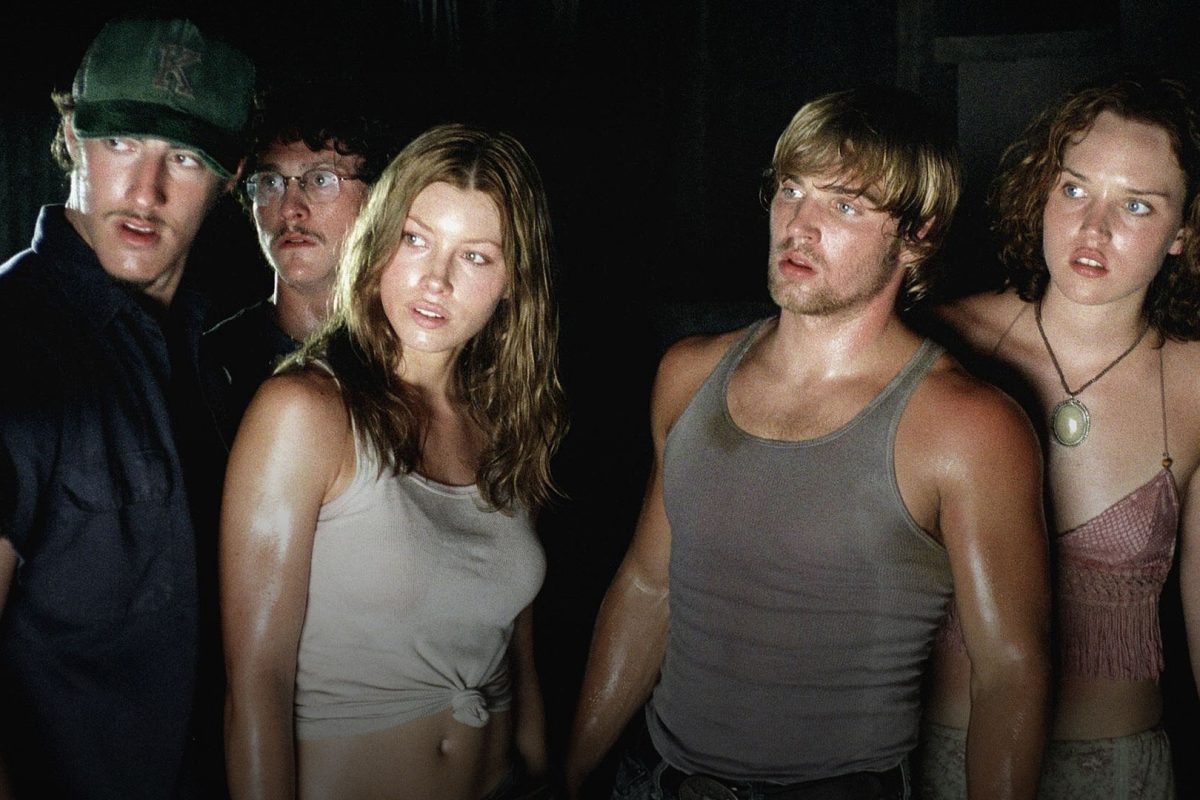
Enter Our Halloween Giveaway!
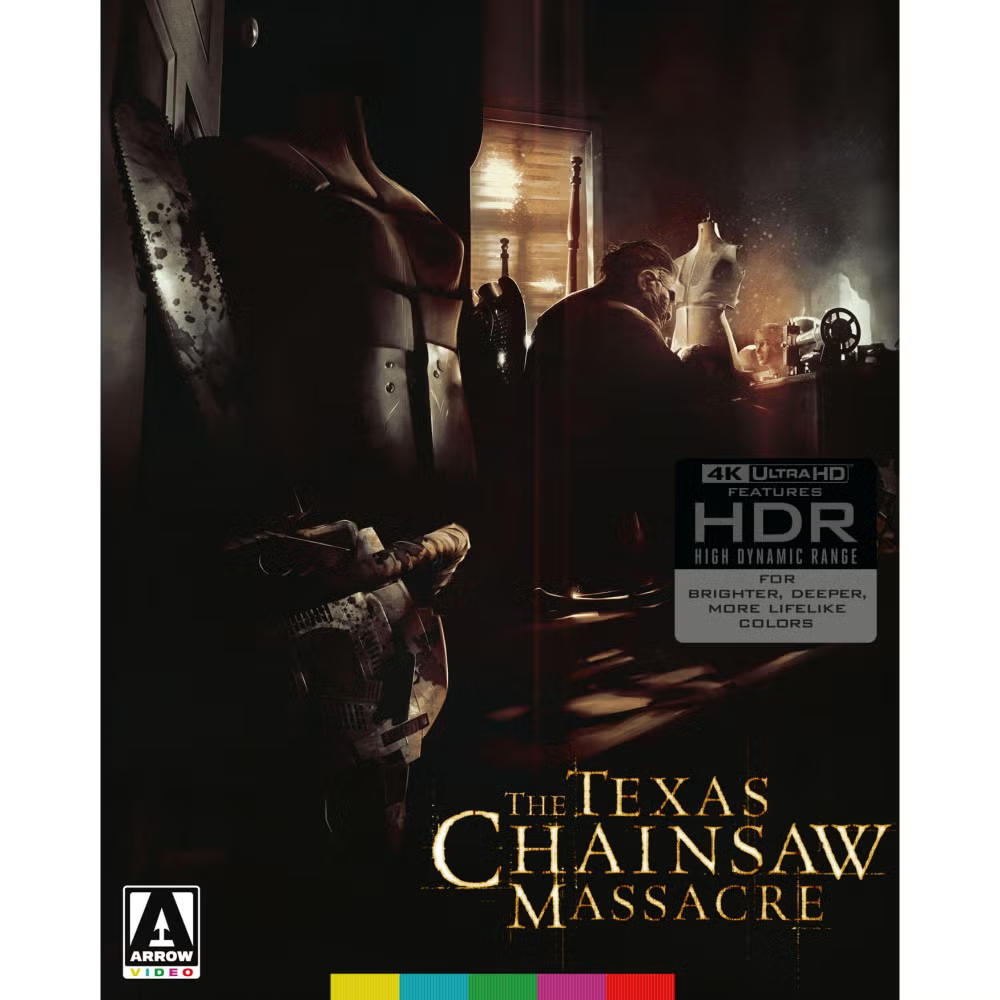
How to Enter:
Step 1. Make sure to FOLLOW US ON FACEBOOK AND JOIN OUR FACEBOOK GROUP!
Step 2. LIKE AND SHARE the giveaway post!
Step 3. This is the most important step, email us at contact@horrorpress.com with your FULL Facebook name (so we can verify you’re in the group) and who your favorite character is from the Texas Chainsaw franchise.
**Giveaway entries are limited to addresses in the United States.**
**All entries must be 18 or older to enter**
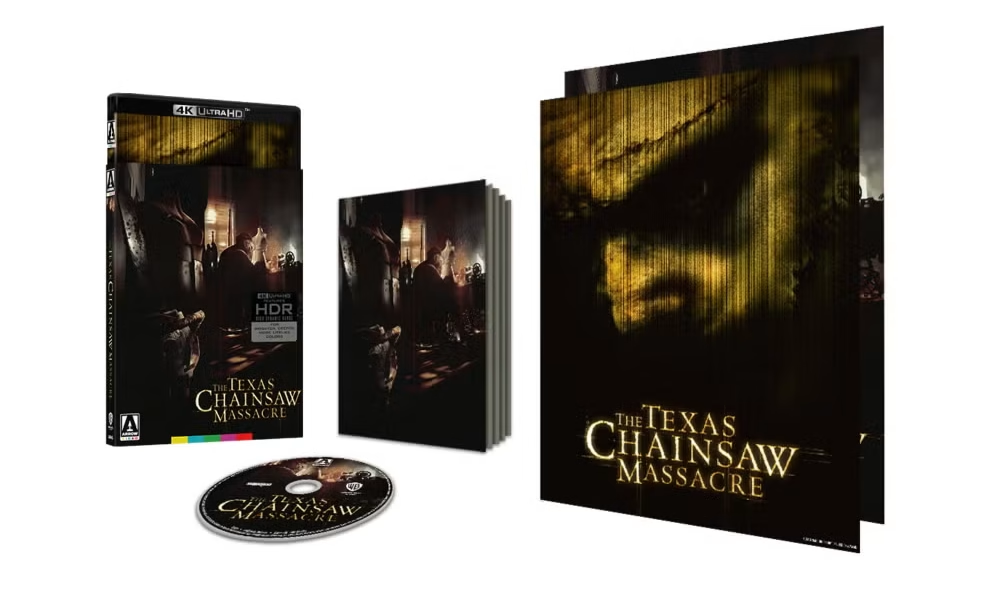
What You’ll Win
The Texas Chainsaw Massacre (2003) Limited Edition 4K UHD from Arrow Video
- 4K (2160p) Ultra HD Blu-ray presentation in Dolby Vision (HDR10 compatible)
- Original DTS-HD MA 7.1 and 5.1 surround audio and lossless stereo audio
- Optional English subtitles for the deaf and hard of hearing
- Brand new audio commentary with Dread Central co-founder Steve “Uncle Creepy” Barton and co-host of The Spooky Picture Show podcast Chris MacGibbon
- Archival audio commentary with director Marcus Nispel, producer Michael Bay, executive producers Brad Fuller and Andrew Form and New Line Cinema founder Robert Shaye
- Archival audio commentary with Marcus Nispel, director of photography Daniel Pearl, production designer Greg Blair, art director Scott Gallager, sound supervisor Trevor Jolly and composer Steve Jablonsky
- Archival audio commentary with Marcus Nispel, Michael Bay, writer Scott Kosar, Brad Fuller, Andrew Form and actors Jessica Biel, Erica Leerhsen, Eric Balfour Jonathan Tucker, Mike Vogel and Andrew Bryniarski
- Reimagining a Classic, a brand new interview with director Marcus Nispel
- Shadows of Yesteryear, a brand new interview with cinematographer Daniel Pearl
- The Lost Leatherface, a brand new interview with actor Brett Wagner
- Masks and Massacres, a brand new interview with makeup effects artist Scott Stoddard
- Chainsaw Symphony, a brand new interview with composer Steve Jablonsky
- Chainsaw Redux: Making A Massacre, a making-of documentary
- Ed Gein: The Ghoul of Plainfield, an in-depth look at the infamous killer who inspired the character of Leatherface
- Severed Parts, a look at the cutting room floor and some of the scenes excised from the final edit
- Deleted scenes including an alternate opening and ending
- Screen tests for Jessica Biel, Eric Balfour and Erica Leerhsen
- Behind-the-scenes featurette
- Cast and crew interviews
- Theatrical trailers and TV spots
- Concept art galleries
- Reversible sleeve featuring original and newly commissioned artwork by Aaron Lea
- Double-sided foldout poster featuring original and newly commissioned artwork by Aaron Lea
- Illustrated collector’s booklet featuring new writing on the film by Michael Gingold
Misc
NYCC 2025 Horror Highlights: A Sneak Peek at ‘The Lost Boys’ Musical, ‘Resident Evil: Requiem,’ and More!
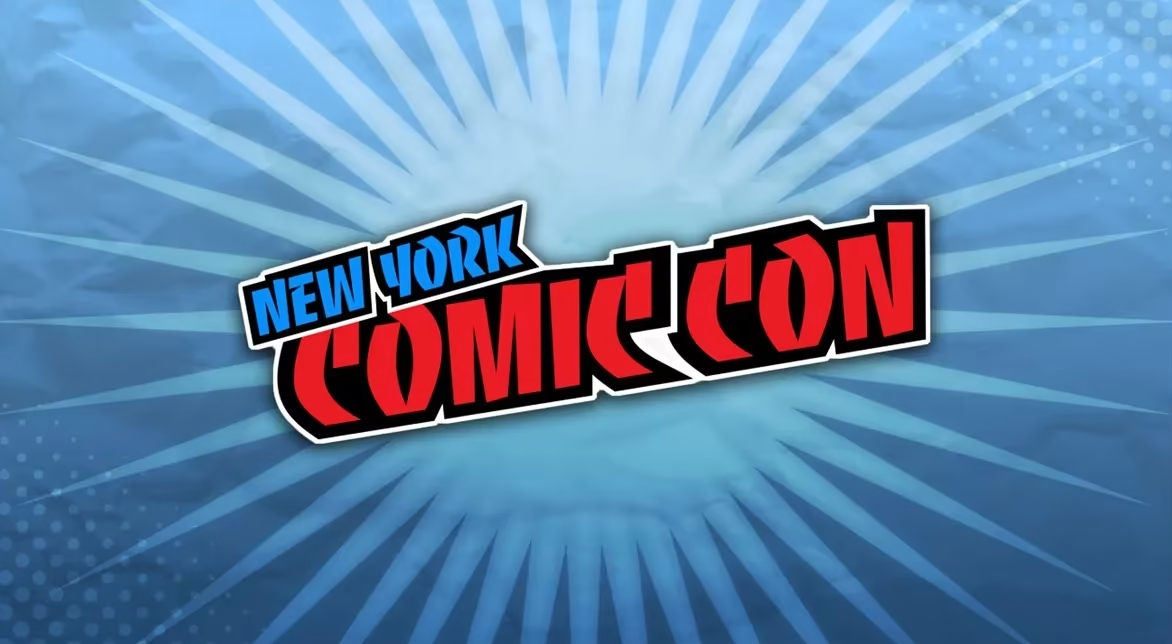
As soon as New York Comic Con announced that its 2025 theme would be “haunted,” I started lacing up my comfy shoes and making a beeline for the Javitz Center! Horror has always been represented at the con, but it felt fitting that it should play a central role in this year’s event at a time when the genre seems more popular than ever.
From beloved family-friendly properties like The Nightmare Before Christmas to pants-dampening titles like the upcoming Resident Evil: Requiem, horror appeared in countless shapes and forms. Here are all the best and scariest insights I gleaned from the show floor, panel rooms, and pop-ups of New York Comic Con 2025!
Our NYCC 2025 Horror Highlights
Resident Evil: Requiem Is Going to Test Your Bladder Strength
Full disclaimer: I’m not a gamer. I’m honestly pretty bad at games, which made my Resident Evil: Requiem play session all the more frightening because I was convinced that everyone around me would realize I’m a fraud. But with easy-to-grasp controls, even for a newb like me, the latest installment in the iconic horror franchise quickly sucked me in and left me on edge for entirely different reasons.
During my 30-minute session, I was introduced to FBI analyst Grace Ashcroft, Requiem’s central character. She swims to consciousness to find herself strapped upside down on a gurney with a needle in her arm, siphoning her blood. After Grace managed to free herself, the controls were handed over to me to explore the creepy facility through Grace’s eyes, looking for a fuse. Some spaces were bathed in red light; others were lit only by flickering bulbs that left me white-knuckling the controller, waiting for something to emerge from the shadows and swallow me whole, not helped by Grace’s anxious, stuttering breathing in my ear.
I took a moment to appreciate how detailed video games have become since my childhood experiences playing Evil Dead: Hail to the King on the original PlayStation (seriously, you can see the dust drifting in beams of light now?!), only for the sound of movement somewhere in the facility to yank me back to the present. I renewed my frantic search for the fuse, only to run blindly into a pitch-black room and encounter something enormous that dragged me into the darkness. Sorry, Grace!
You can find out what happens next when Resident Evil: Requiem releases for the PlayStation 5, Xbox Series X|S, PC, and Nintendo Switch 2 on February 27, 2026.
Megan Fox Is Among the New Cast Members in Five Nights at Freddy’s 2—And Blumhouse Hasn’t Given Up on Its Other m3gan Yet
Blumhouse made several announcements at their NYCC panel, most notably that Megan Fox (Jennifer’s Body) is voicing Toy Chica in director Emma Tammi’s highly anticipated sequel Five Nights at Freddy’s 2, coming to theaters on December 5. Other new additions to the cast include YouTuber Matthew Patrick, aka MatPat, who cameoed in the first movie and will voice Toy Bonnie, and Kellen Goff, who has voiced multiple characters in the game series and will now lend his pipes to Toy Freddy.
I’m interested in Five Nights at Freddy’s 2, not least because my best friend is terrified of the franchise and makes a wildly entertaining moviegoing companion—but I’m more interested in the future of another Blumhouse franchise, M3GAN. After the sequel underperformed, likely due in part to its hard genre pivot away from horror and into action territory, the future of the killer doll is uncertain. But in a special industry presentation on “The Business of Fear,” Jason Blum revealed that “we’re all working to keep M3GAN alive,” adding that Blumhouse is exploring other potential mediums before trying to resurrect her on film.
Does that mean a M3GAN video game might come our way in the future, or perhaps a TV series? I don’t know, but I have a feeling this isn’t the last we’ve seen of the silicone diva.
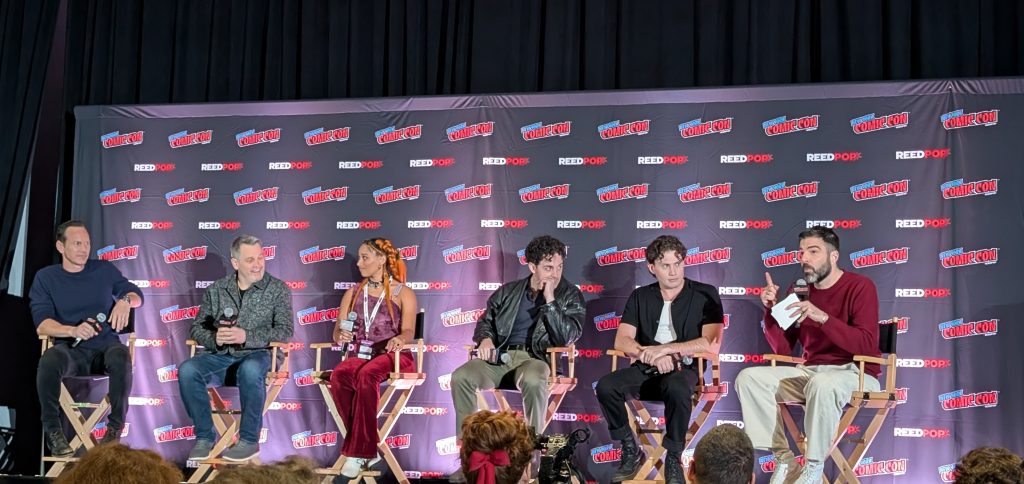
Photo taken by Samantha McLaren.
The Lost Boys: A New Musical Will Feature Flying Stunts and a Live Vampire Band
My queer heart is a sucker for musical adaptations of horror films I love, so you can be certain that I’ll be heading down to the Santa Carla Boulevard—aka Broadway’s Palace Theater—for The Lost Boys: A New Musical, which begins previews on March 27, 2026. At their NYCC panel, producer Patrick Wilson (The Conjuring franchise), director Michael Arden (Maybe Happy Ending), and cast members LJ Benet, Ali Louis Bourzgui, and Maria Wirries revealed why they feel Joel Schumacher’s 1987 classic translates so well to the stage, and what audiences can look forward to.
“There’s something that I see with both horror movies, musicals, and superhero movies—there’s an element of melodrama that’s really rewarding,” says Wilson, who began his career in musical theater and worked with Schumacher on the director’s 2004 film adaptation of The Phantom of the Opera. “Some people view it as camp, but there’s a reality of it being heightened that felt like this story cemented itself so much to being a musical.”
“They’re a biker gang, after all, and there’s a level of theatricality to that in and of itself,” says Arden. “Our biker gang also happens to play instruments.”
That’s right: the vampires will be playing instruments live on stage, which made casting twice as hard. Ali Louis Bourzgui, who plays David, the character portrayed by Kiefer Sutherland in the film, reveals that he plays guitar. And that wasn’t the only unusual request in the casting call: auditions included a flying test. (Presumably wires were involved, unless Arden has found himself a real cabal of vampires in his cast.)
Other highlights that fans can look forward to include killer music from one of Arden’s favorite bands, The Rescues. You can listen to the song “Have to Have You” right now, featuring instrumentals from Slash. The director also teases that many fan-favorite moments from the film will feature in some way in the musical, including the bridge scene and, yes, even the sexy saxophone guy.
Greg Nicotero’s Guts & Glory Marks a New Challenge for a Legend of the Business
If you like looking at gnarly practical effects in horror movies, chances are you’re familiar with Greg Nicotero’s work, whether you realize it or not. The legendary SFX artist has worked on everything from George Romero’s Day of the Dead and Sam Raimi’s Evil Dead II to Kill Bill and, more recently, The Walking Dead. The impressive extent of his resume was made clear at the panel “Shudder is Here to Scare the S*** Out of You,” in which almost any film mentioned by the other panelists was met by a small smile and a humble murmur of “worked on that” into the mic, often followed by a wild anecdote. Nicotero seems like the most interesting man in the world to grab a drink with, and his new horror competition show for Shudder—Guts & Glory—will let us see more of the man behind the makeup brush.
“Guts & Glory is one of the most fun times I’ve had on a show,” Nicotero says, teasing that the series is “part Sam Raimi, part Halloween Horror Nights, and part Survivor.”
In the six-episode first season, contestants are dropped into an Alabama swamp, where there’s an urban legend about an evil spirit. “One of the contestants gets possessed by the evil spirit, people start dying off, but in the meantime, they’re still competing and there’s a prize,” Nicotero explains.
Guts & Glory is effects-heavy, which was challenging to do in an unscripted series relying on real people’s real-time reactions. “You do a movie, you can cut and try it again,” Nicotero explains. “[This] was completely out of my wheelhouse and out of my comfort zone, but I’m really, really proud of it.”
Nicotero’s Creepshow was one of the first original shows to debut on Shudder, so he’s truly part of the DNA of the horror streamer, which celebrated its 10th anniversary this year. Guts & Glory premieres on October 14 as part of Shudder’s Season of Screams programming.
Horror Short The Littles Deserves the Big-Screen Feature Treatment
Some short films are perfectly suited to their bite-sized format, while others contain the seeds of something much bigger. At the New York Premiere of The Littles, a new short written and directed by American Horror Story producer Andrew Duplessie, I could immediately see the potential for the feature film that Duplessie hopes to make.
Equal parts charming and unsettling, The Littles stars M3GAN’s Violet McGraw as a little girl with a loose floorboard in her bedroom. One night, a scuffling sound and a crack of light between the boards lead the little girl to discover that her family isn’t alone in the house…
Duplessie says The Littles was inspired by his own experiences growing up in a creaky old house with a no-doubt overactive imagination. The short features creepy-cute stop-motion animation from Anthony Scott (The Nightmare Before Christmas), puppets by Katy Strutz (Guillermo del Toro’s Pinocchio), and some truly adorable miniature sets by Aiden Creates, all blended perfectly with the live-action scenes. Check it out if it’s playing at a festival near you, and watch this space for a (fingers-crossed) future feature!
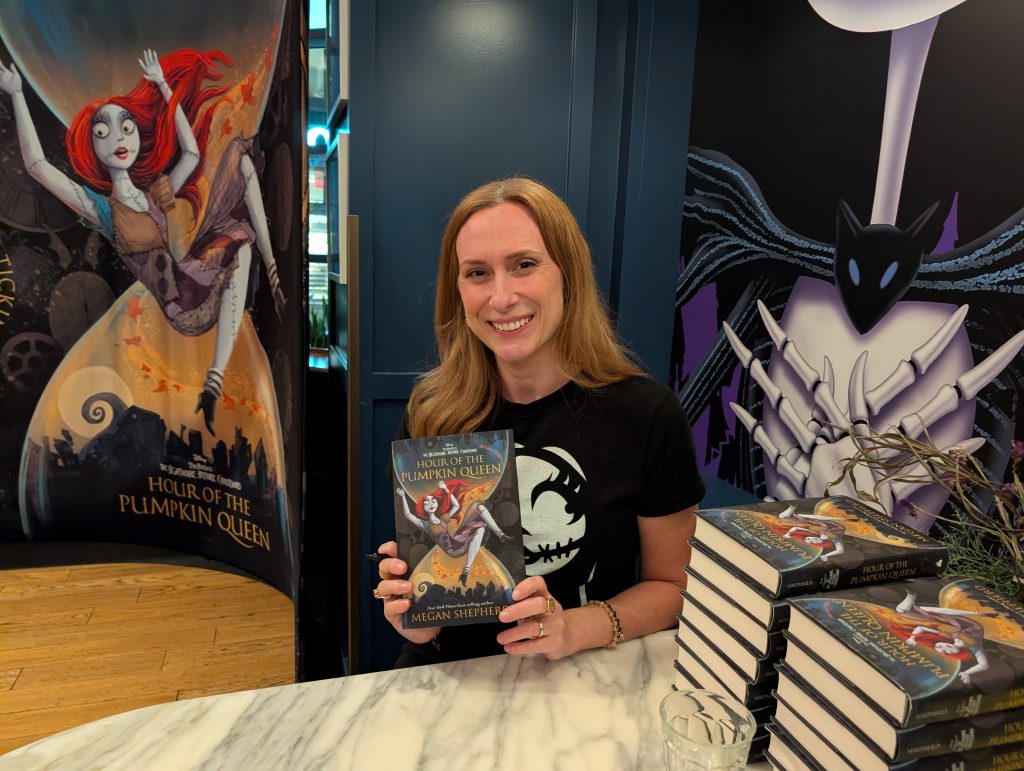
Photo taken by Samantha McLaren.
Disney Publishing’s New The Nightmare Before Christmas Tie-in Novel Welcomes Younger Fans into the Scary Fun
NYCC’s horror happenings weren’t all geared toward an adult audience. Disney Publishing took over Daily Provisions Manhattan West for a pop-up experience inspired by The Nightmare Before Christmas, featuring themed food and drinks like a delectable Pumpkin Potion coffee that I could honestly drink all season long.
At a media and creator event in the space, I took a look at the newly released Hour of the Pumpkin Queen from New York Times best-selling author Megan Shepherd, who also wrote the official novelization of The Nightmare Before Christmas for the film’s 30th anniversary in 2023. In this new tie-in novel, Sally and her rag doll apprentice, Luna, embark on a time-bending adventure to save Jack Skellington and Halloween Town after falling through a mysterious portal.
I was gifted a copy of the book by Disney, but all opinions are my own here. I’m looking forward to giving it a read during the inevitable Halloween hangover that takes place in November, before likely passing it on to my young nieces when they’re old enough. It’s a full novel, not a picture book, so definitely geared more toward a YA audience, but between the beautiful artwork on the cover and the seasonal theme, it might just be the perfect gift for the budding horror lover in your life.
That’s a wrap on New York Comic Con 2025! Be sure to bookmark Horror Press if you haven’t already so you never miss our coverage of conventions, festivals, and more.


























